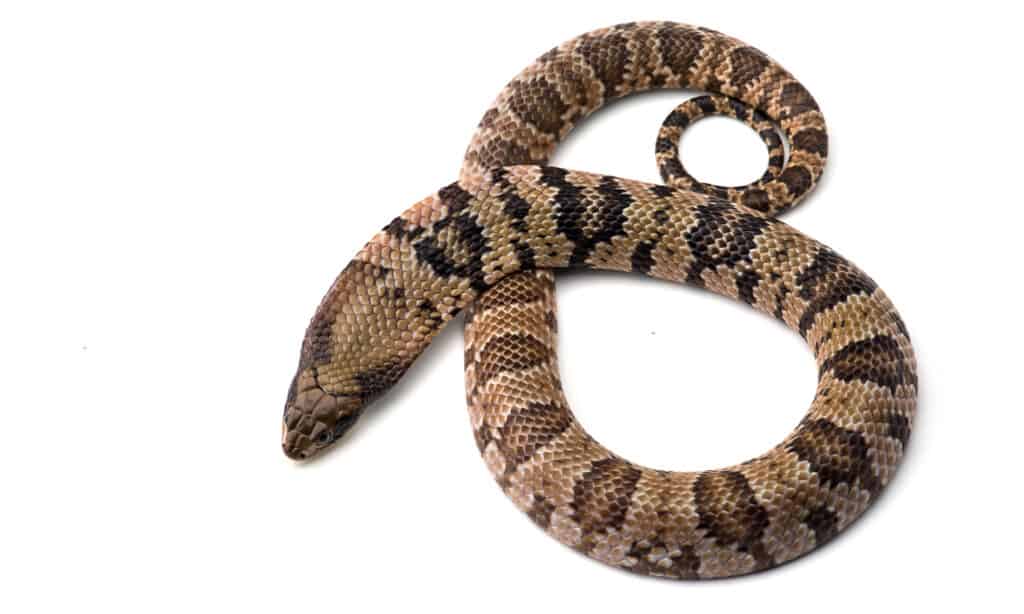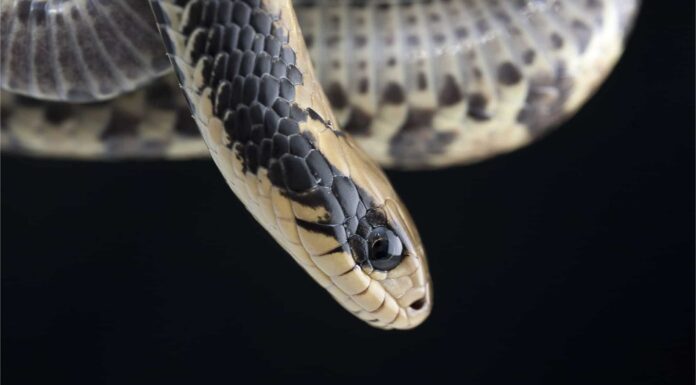The false water cobra is a New World snake species that is also known as the Brazilian smooth snake.
Its common name comes from the hood it raises like a true cobra does, although it stays horizontal rather than rearing up. Also, its colors and pattern are similar to those of the trueF water cobras (genus Boulengerina). The venom from its bite is not fatal, and the species is often for sale as a pet.
4 False Water Cobra Amazing Facts
- There are several color morphs, including lavender.
- It takes 1.5mg of liquid venom to kill a human. This species produces 0.-50 microliters in liquid venom and 1.3mg in solid venom. The more time it hangs on in a bite, the more venom it can inject.
- In large quantities, the venom causes swelling, discomfort, and bouts of muscle paralysis, and inhibits blood clotting.
- No fatalities have been attributed to false water cobra bites, and most people do not experience negative reactions if they don’t let the snakes chew on them.
Where To Find False Water Cobras
False water cobras are native to South America. They live in southern Brazil, eastern Bolivia, Paraguay, and northern Argentina, where temperatures during warm months (November to March) average 80°F and 65°F on average during colder months. Their habitat is terrestrial and semi-aquatic in wet, tropical, and humid areas, usually in marshlands and other inland wetlands, near streams or the floodplains of rivers, if not forests, savannahs, shrublands, and grasslands. They are diurnal creatures that spend most of their time climbing, burrowing, and swimming. You can find them at heights of 0-800m. Their lifespan is 12-20 years.
Scientific Name
The scientific name for the false water cobra is Hydrodynastes gigas. Alternate names include Brazilian smooth snake, false cobra, and South American water cobra. It is in the class Reptilia (reptiles), order Squamata (scaled reptiles), and snake family Colubridae. Colubridae has 249 genera. Its genus Hydrodynastes has one other species, Hydrodynastes bicinctus. There are no subspecies. In South America, it is called vibora ladradora (barking snake) in Spanish, and ñacaniná, boipevassu, yacanina, and surucucu-do-pantanal in Guarani.
Population and Conservation Status
The population of the false water cobra is listed as stable. Its conservation status is Least Concern according to the IUCN Red List.
Appearance and Description
The false water cobra seems to initially resemble a true cobra in both color pattern and hood raising. Its typical color pattern is olive green or brown, with dark spots and bands all over, and a darkening background color and banding near the tail. There are also splashes of yellow, brown, and black. The hood’s size is 4-8 inches wide. However, the snake does not rear up but stays horizontal while raising its hood, unlike a true cobra. Also, there are other color morphs and there are a few distinct ones. Hypo morphs lack brown and black and instead have yellow, orange, and light brown. One of the rarest and highest in price color morphs is lavender, which does not have any yellows, browns, or blacks. Lavender morphs appear grey, pink, and light purple and are rarely for sale in North America, but are available for sale in Europe. Other color morphs are silver, golden, and dark.
Female false water cobras are larger in size than males. Males tend to be 4-5ft long while females measure 6-8ft long, but they can be up to 10ft long. Both can weigh up to 10lbs and be 4-8in wide. However, it is not uncommon for females to exceed 10lbs. Hatchlings measure 14-16in long, while hatchlings and juveniles have darker coloring than adults and lack their dark eyes. The larger the size of the snake while young, the longer its lifespan.

PetlinDmitry/Shutterstock.com
False Water Cobra Venom: How Dangerous Are They?
The false water cobra has a carnivorous diet. Its main prey is fish, but tadpoles, frogs, and other aquatic amphibians are also part of its diet, as well as wetland reptiles, birds, and mammals. It hunts by grabbing and partially coiling its body around its prey, then swallowing it live.
The false water cobra lacks a large venom gland but instead has a Duvernoy’s gland, common to rear-fanged snakes. It is separate from the salivary gland and its secretions are toxic. However, this snake does not usually try to envenomate when fighting off predators or showing aggression. Instead, it wounds by biting with a slashing motion.
False Water Cobra Behavior and Humans
False water cobras make great pets. The price of a false water cobra depends on its age as well as its color morph. Babies range from $250 – 500. Additionally, the price of its enclosure, absorbing substrate, decorations, a hide box, temperature and lighting, humidity, water basin, and food must all be factored into the initial purchase as well as ongoing costs of care and maintenance of its habitat.
The ideal temperature for this species is 78 degrees Fahrenheit at night and 85 degrees during the day. An incubation temperature of 83 degrees Fahrenheit is enough to get eggs to hatch after about 60 days.
The enclosure should be at least 48in L x 18in H x 24in W, but 72in L x 18in H x 30in W. It needs ventilation for the humidity. An ideal absorbing substrate is cypress mulch or orchid bark. To set up a temperature gradient, create a basking site of 90-95 degrees F with a basking light, and a cooler side of 78-85 degrees F. Humidity should remain about 50-60 percent, which you can measure with a hygrometer. Usually, humidity is maintained by the absorbing substrate. You should keep its habitat scrupulously clean.
As for food, any animal protein source should be about the width of your snake’s head. Live or defrosted pinky mice, adult mice, large rats, chicks, frogs, and fish are some examples of food options.
(Frequently Asked Questions)
Is a false water cobra poisonous?
No, it is not poisonous, but it is somewhat venomous.
Are false water cobras good pets?
Yes, they make good pets, and they can be tamed.
How big do false water cobras get?
Males are usually 4-5ft long and females are 6-8 ft long.
Is a false water cobra a cobra?
No, it is not a true cobra, which is a Naja species. It’s not even in the same family, as the cobra is in Elapidae.
Can a false water cobra kill you?
No, its venom is not enough to kill, and it doesn’t have negative or lasting effects unless the snake has been allowed to chew while biting.
